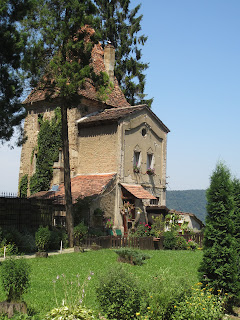| Today was one of Janine and my favorite days so far! After our two-hour train ride from Sibiu, we decided to take a guided tour of the citadel, since much our research about this place was conflicting, and none of the signs were in English. Our tour guides turned out to be these two local high school girls working at a non-profit organization, and they were very informative; even better was the fact that Janine and I were the only ones on the tour, so we were able to ask them lots of questions, not only about Sighisoara, but also about Romanian life in general. I'm not going to relate everything they told us, but these pictures and text should hit some of the highlights. First, the statue above is a bust of Vlad Drac, legendary Romanian king who was thought to inspire the vampire Dracula. We found out today that though the story of Dracula does take place in Transylvania, the novel was actually written, then the name of the vampire and its setting changed after the author found out about Vlad Drac. The real king, who held the throne a total of three times in the twelfth century, was quite brutual--he was famous for torturing his enemies by impaling them through the spine, so that it would take them 48 painful hours to die. He also frequently tortured his subjects for minor crimes, particularly the Germans who were living in Transylvania. Anyhow, Dracula is not based on him, but that apparently does not stop lots of people from coming and roaming the citadel where the real Vlad Drac spent his youth and ruled. |


















































